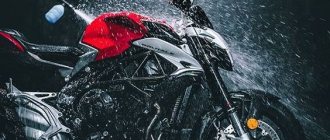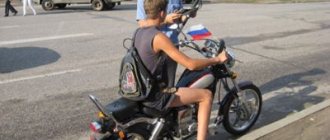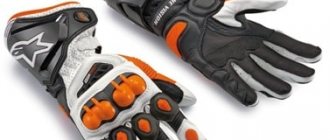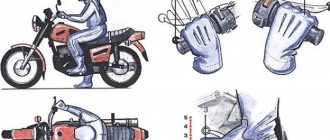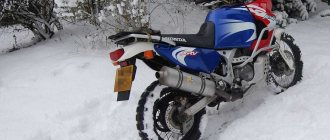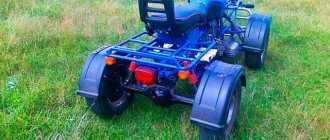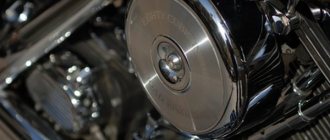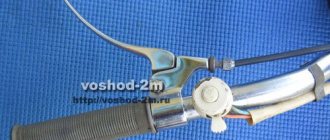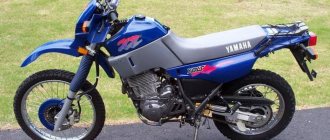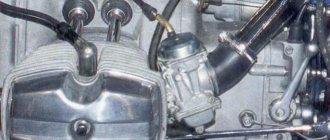Let's start with the most powerful system on a modern racing motorcycle. No, it's not an engine. The most “powerful” component of two-wheeled beasts is the braking system, and even road sportbikes are capable of slowing down much more vigorously than accelerating.
The Suzuki GSV-R has a carbon brake disc and Brembo calipers. For dry weather, Honda RC211V motorcycles use carbon brake discs.
The requirements for the braking system of racing motorcycles are very varied and difficult to meet. Firstly, the system must be very powerful and effectively reduce speeds from two to three hundred km/h to 30-40 km/h. Secondly, it must provide the pilot with such a high level of “brake feel” that he can get as close as possible to locking the wheel without locking it. The third requirement is mass. Brake components located directly on the wheel affect the unsprung mass and the gyroscopic effect of the rotating wheel. For a racing motorcycle, it is important to minimize both of these parameters (the amount of unsprung mass affects the ability of the suspension to effectively handle road irregularities, and the gyroscopic effect affects the ability of the motorcycle to quickly change its trajectory). And the last requirement is related to temperature, because all the kinetic energy of a rushing animal turns into heat when braking. To be very precise, there are three requirements related to temperature.
Rear brake disc Honda RC211V – ventilated
First, the braking system must dissipate heat effectively and not overheat. Secondly, the friction material must successfully withstand high temperatures (after all, even with constant cooling by the incoming air flow, brake discs easily heat up to 300-400 degrees). And thirdly, the braking characteristics must remain stable, i.e. change as little as possible during the race (so that the pilot does not waste energy getting used to the “character” of the brakes changing due to temperature changes and wear).
PVM kit: wheel disc, petal brake disc and brake caliper
The easiest way to meet this list of conflicting requirements is in the GP-125 and GP-250 classes. Light and relatively low-power motorcycles often accelerate to “only” 220-230 km/h and are able to take most turns at very high speeds, so the “fork” between the initial and final speeds is quite narrow, and, as a result, in these classes the brake requirements systems are the softest. Often, 125s have only one brake disc at the front (the braking force from slowing down a light motorcycle is not able to sensitively twist the front fork, so in the “125” class this negative effect can be neglected) and a conventional two-piston caliper, which is lighter than four-piston ones and reduces unsprung weight. The 250s get four-piston radial calipers and dual brake discs on the wheel.
Carbon brake discs require carbon brake pads
Compared to GP two-stroke bikes, SBK motorcycles weigh significantly more and have higher speeds. Therefore, the load on the braking system is more serious here. Because of this, on many superbikes, along with classic (flat) brake discs, petal-type (wavy) brake discs are installed. These discs have a number of advantages. Firstly, they are lighter (we save on unsprung weight and reduce the gyroscopic effect!). Secondly, the complex shape of these discs makes it possible to better remove dirt, dust and pad wear products from the friction zone, and also makes the discs more “springy”, reducing the likelihood of them bending due to temperature changes. And thirdly, they have a lower heat capacity (due to reduced mass), but a larger cooling surface, and therefore reach operating temperature faster, which, moreover, turns out to be more stable.
The end of the brake disc of the Kawasaki ZX-RR motorcycle has paint that changes color when it reaches a certain temperature.
The top of the “braking” pyramid is the anchors of MotoGP machines. Motorcycles of this class easily reach 330-340 km/h, which leads to absolutely extreme braking conditions. Therefore, to meet these requirements, it is necessary to use exotic materials, namely carbon. Brake discs baked from carbon are approximately half the weight of steel, which was the primary reason for their use on racing motorcycles. They happily withstand high temperatures and, unlike steel wheels, not only do not lose efficiency when heated, but rather progressively gain strength and provide very stable performance throughout almost the entire race. Almost. Carbon rims also have disadvantages. The first is that effective deceleration is ensured only after reaching operating temperature (approximately 450 degrees, 500F), and until this point the brakes work relatively sluggishly. Because of this disadvantage, carbon-based discs and pads are unsuitable in “wet” racing, when the water does not allow them to “warm up”. Therefore, for “wet” tasks, teams have conventional steel brake discs in stock.
Under racing loads, brake discs require regular replacement.
The second disadvantage is the small resource and high price. Discs with pads last for 1000-1500 km, and the price of one disc is around $2000. A sensitive bite for a racing team's budget. The third “minus” is the high temperature of the pads (by the way, only carbon pads are used with carbon discs). To prevent the brake fluid from boiling, holes are drilled in the pistons to improve their cooling. And to monitor the temperature of brake calipers and discs, electronic temperature sensors are used (see the “Electronics” part in one of the following issues) and special stickers and paints that change color when a certain temperature is reached.
Beringer brakes came to the road from endurance racing
A separate line in braking technology is the “jaws” of motorcycles participating in endurance racing. The specificity of such racing turns the requirements for “regular” racing motorcycles upside down. A huge distance (up to several thousand kilometers) automatically leads to the need for numerous pit stops to replace tires, brake pads, adjust the stretch chain, refuel and even repair, and this is a waste of time. Therefore, endurance racing motorcycles are designed to minimize the length and number of pit stops. This also influenced the design of the braking system.
The rear brake in endurance racing is also controlled by a Beringer cylinder
First of all, the parts of the brake system (and not only) have different colors: on one side of the motorcycle they are red, on the other they are blue. This allows mechanics to quickly determine which side to mount brake calipers or insert a wheel axle on. The wheel axle is equipped with special guides that allow you to get into it with a pneumatic wrench without looking, in the dark of the night or in a terrible downpour. The brake calipers also have guides that make it easier to install the wheel (so that the brake disc snaps into place right away). This is also facilitated by magnetic pistons that keep the pads from skewing when the wheel is removed. The brake pads themselves are closer in properties to road ones: they last longer, but are less tolerant of overheating.
This connector allows you to change brake calipers without depressurizing the brake system
A number of technical "tricks" are used in almost all classes of racing motorcycles. To facilitate maintenance, a hydraulic “connector” is often installed in the section of the brake lines (the lines are exclusively reinforced, since even new rubber hoses are not able to provide good feedback), which allows you to disconnect the components of the brake system without depressurization (and, as a result, the need to bleed the brake system ). To reduce the likelihood of the front brake lever breaking in the event of a fall, it is made to rotate, so that in the event of contact with the ground it simply “breaks” upward. After that, you just need to “snap” it back, and you can move on. Adjustment of the position of the front brake lever is carried out on the left clip-on - so that you can adjust it on the fly. A duplicate rear brake lever is often installed there, controlled by the thumb of the left hand. This allows finer control of the rear brake, as well as applying it when moving the foot is difficult (for example, in turns).
Segmented brake discs are still a rarity
Finally, let’s talk about the rear brakes themselves. Due to the low rear braking performance of modern sportbikes, the rear brake is used most often in wet racing, to check the level of rear wheel traction or to stabilize the motorcycle in certain “sticky” situations. Therefore, the use of composite brake discs is not justified here. Most often, the rear wheel is braked by a floating steel disc, petal-type disc, or ventilated disc.
Author Anton Barsukov, photo by the author.
PVM produces a full range of components for motorcycle braking systems. This lever allows you to adjust the progression of changes in braking force. Ceramic discs are similar to carbon ones, but cheaper to manufacture. A brake disc mounted on the rim is another original and effective technical solution. PVM brake disc of a classic design. Ceramic disc on the front wheel is more justified Ceramic brake discs are cheaper to manufacture compared to carbon Brake calipers are paired with a Brembo master cylinder Yamaha, like other teams, uses a combination of Brembo + carbon discs Yellow sticker with numbers is a thermometer The Kawasaki team uses Brembo calipers and carbon brake discs discs Petal-type rear brake disc Kawasaki ZX-RR This brake disc was made by the owner specifically for his favorite jixer Only a very powerful brake disc can stop a motorcycle with a jet engine To simplify the design and improve reliability, the rear brake pedal is returned by an elastic band The position of the front brake handle can be adjusted with your left hand on the move Front brake lever adjustment knob Famous Beringer twin brake discs The Beringer brake test bench can determine how much force is enough for stoppies When six-piston calipers are not enough, you can install eight-piston Brake feel test bench Sicom brake calipers are designed specifically for ceramic brake discs Ceramic brake discs are cheaper carbon fiber and rain-resistant Beringer master cylinder ensures consistent front brake performance
What factors influence braking?
- Wheel grip. A major factor influencing all maneuvers, including turning and braking. The better the grip, the more stable the motorcycle will be and the faster it will respond to steering.
- Contact patch. This is the area of grip on the road. The larger it is, the easier it is to brake.
- Wheel load. Proper braking requires that the wheel that bears the heaviest load is used. This can be either the front or rear wheels.
About the myth about “I put the motorcycle down”
You can often hear a phrase in the style of “I realized that I didn’t have time to brake, so I put the motorcycle down.” It is all a lie, from beginning to end. In an emergency situation, only reflexes and the instinct of self-preservation are triggered. There cannot be any conscious analysis about whether you have time to slow down or not. Therefore, in order for the reflexes to work correctly, it is necessary to regularly practice emergency braking on the site. Many times.
Now about “put the motorcycle down”. Any bike brakes better on two wheels, with rubber adhering to the asphalt, using both brakes - than in an uncontrolled flight on its side, sliding plastic and metal along the road, without any grip on the surface.
- If a fall occurs, you and your motorcycle will fly into an obstacle at the same speed at which you fell;
- If you tried to brake until the last moment, you have a chance to reduce the speed enough to make a subsequent maneuver and avoid a collision, or if you fail to dodge, you will collide with an obstacle at minimum speed, your chances of staying alive and not even getting hurt are increase significantly;
- If there are pedestrians ahead, a bike flying at the same speed on its side crashes into their legs, which leads to multiple fractures and a strong blow to the head on the asphalt, with a wide amplitude. The maximum speed reduced by proper braking, even if it leads to a collision, the consequences will be much less serious, perhaps even just a slight jolt.
Therefore, everyone who says that “I realized that I didn’t have time to brake, and therefore I put the motorcycle down” - stop lying and looking for excuses for yourself. It’s better to enroll in a good motorcycle school, where they will teach you how to brake properly.
How does the braking system work?
Before we figure out how to brake properly, let's find out how the motorcycle braking system works. It uses friction to slow down the moving parts of the mechanism: roughly speaking, the brake pads clamp the disc. Most modern bikes use a disc system, with drum brakes installed on the rear on some cruisers and smaller models. The brake drive can be hydraulic or mechanical.
The main requirement for modern braking systems is not at all an increase in the force that the pads exert on the disc, but a minimum weight and high sensitivity of the motorcycle brakes. At the same time, the stiffness of the fork and tires affects the performance of the braking system. Since friction is the basis of braking, pads are made from materials that are resistant to abrasion and high temperatures: copper, brass, lead, carbon, Kevlar and graphite. Cast iron or stainless steel are used to make discs; carbon fiber discs are installed on racing motorcycles.
Although drum brakes are now a rarity, historically they were the first type of braking system. The main element is the drum, inside of which there is a braking mechanism. Because the drum is enclosed, the heat generated when the disc slows down is not dissipated, and the brakes quickly overheat.
Disc brakes are open, they rotate with the wheel. Adjacent to the disc is a caliper that contains pistons or pads. When you press the handle, the pistons move and the pad is pressed against the disc. On modern motorcycles, the front wheel is equipped with two discs, and the rear wheel has one. This is due to the fact that when braking, more than half of the bike's weight is on the front wheel.
Sports riding technique. Read before your spring trip.
Contents of the material
- Sports riding technique. Read before your spring trip.
- Chapter 1. Weak Link.
- Chapter 2. Basics of braking and steering.
- Chapter 3. Keep your eyes open.
- Chapter 4. Steer confidently.
- Chapter 5. Under gas.
- Chapter 6. Brakes
- Chapter 7. All about external factors.
- Chapter 8. Time to go to the track.
- Chapter 9. Survive in the city.
- Chapter 10. Traveling in a group.
- All pages
Page 1 of 11
How to develop skills that improve speed, safety and confidence on the streets and tracks.
Acknowledgments
When I finished my first book, the relief was so great that I wanted to thank everyone on the planet. But even if I wanted to thank only those who helped me during my 29-year biography, then the list would be very long and very significant for me. However, I was asked, if possible, to limit myself to people who helped in the work on the book.
David Bull Publishing. Thanks to designers Tom Morgan and Anna Gilbert for their excellent work, and to editor Rachel Bernstein for her wonderful editing. I would like to express my deepest gratitude to my friend and fellow rider, publisher David Bull.
Photographers. As we journalists say: no pictures, no article. Without the competent work of these people there would be no book. Special thanks to photography aces Brian Jay Nelson, Brian Blades and Dennis Morrison. Thanks also to Jeff Allen, Dexter Ford, Patrick Gosling, Fran Kuhn, Gary Lehman, Jay McNally, George McQuiston, Tom Ryles, Dennis Scully, and Mark Urbano. Great job, gentlemen.
Illustrator. Special thanks to Hector Cadematori, a motorcycle illustrator who can understand the most complex idea and then depict it clearly and convincingly.
Publisher of Cycle World and Sportbike magazines. These guys took pictures, posed for photos, and helped in a hundred other ways. Thanks to super riders Don Kanet and Mike Sernicki. Thanks also to David Edwards, Brian Catterson, Matthew Miles, Mark Heuer, Jimmy Lewis, Robin Davis, Brad Zerbel, Elani Anderson, Paul Dan, Jason Colon, Ben Welsh, Jason Black, Jim Yeardley, Todd Egan, and John Casimer. Great people, great articles. And, David, I couldn't have done it without you.
Publisher of Motorcyclist and Sport Rider magazines. I started writing the book while I was working at Sport Rider, and I want to thank the team who put the idea into my head: Art Friedman, Mitch Boehm, Lance Holst, Jason Black, Sebhan Burns, and Angela Barosso.
My racing partners. Racing taught me a lot, all because with such great support I could focus solely on driving. I would like to thank everyone who helped me at the races, but I will limit it to the team with which I won club and national championships: Steve Biganski, Craig Arion, Kevin Arion, Steve Johnson, John Cordona, Dan Kiley, Glenn Cook, Dennis Smith, Jim Allen , Bob Graham, John Winslett, Tommy Lynch and Larry Pegram.
I would also like to thank those who taught me to ride and race: Keith Code, Eddie Lawson, Wayne Rainey, Thomas Stevens, my dirt track coach Jeff Haney and most importantly, the boss of my motorcycle school, Freddie Spencer. I have learned and continue to learn a lot from Kenny Roberts' book, and I thank King Kenny for his foreword.
I also have to thank my wonderful parents, Ellie and Bill Jenatsch, my wonderful wife Judy, who inspired me, rode with me and made my life so much easier, and the Lord our God Jesus Christ. Finally, I thank all the readers of this book.
Nick Jenach, January 2003
PREFACE
The path to the right skills is training, training, training...
The guy who wrote this book has seen first-hand how hard the best racers work to get to the top and stay there. Nick learned dirt track on my California ranch with guys like Wayne Rainey, Eddie Lawson, John Kosinski and my sons Kenny Junior and Curtis. Driving on asphalt is just a game compared to training on a dirt track.
I first met Nick in 1990 when he came to the Ranch with Eddie Lawson. At that time, he was just starting to race in the 250 class. A journalist is always a hemorrhoid, so we drove him hard in motocross and dirt track. But he didn't complain. The younger one was then starting to race the 250 in the WERA championship, so I kept an eye on the sports news. From them I learned that Nick finished in the top three in the AMA championship several times. He also performed well on four-stroke Hondas. Not bad for a journalist.
This book is not about racing, but mainly about driving on public roads. Where the goal is not limited to just improving lap times. Most people cannot even drive a car properly, let alone a motorcycle. I hope that “Sport Riding Techniques” will help someone. I believe in training and technology, and this applies to any level - from Moto Grand Prix to simple weekend rides. I know Nick has been writing articles for motorcycle magazines about racing techniques for many years, so I feel confident in recommending this book. I like anything that improves my driving skills.
Nick mentioned that my book, Motorcycle Riding Techniques, helped him. I hope his book helps you. He worked hard on himself, and this book is the culmination of his efforts.
Kenny Roberts.
THE BIRTH OF A BOOK
Welcome to Sports Riding Techniques, a book dedicated to efficient motorcycle riding on the streets and race tracks. I mentioned the tracks because only there you can learn the absolute limits of the bike and its rider. Some things in this book are best used only in racing. However, the book is mainly concerned with driving on ordinary roads, because they require special skills and pose their own demands. Anyone who has ever driven along a winding road has become forever addicted to this exhilarating, delightful and (if careless) potentially dangerous activity.
This book is based on numerous articles I have written about the human side of the rider-motorcycle system for Motorcyclist, Sport Rider, Sportbike, and Cycle World magazines. Probably the most successful article was “Temp”, in which I described the skills that allow you to pilot a sportbike on ordinary streets without ending up in a hospital or in prison. Since then, the article has been revised and republished several times. In this book, I tried not only to present in more detail the ideas of that article, but also to supplement them with many other aspects - from surviving on the streets to participating in races. The book contains almost no advice on setting up the bike, it's about how to control the bike.
The pinnacle of my career as a journalist was an invitation to work at the Freddie Spencer School of Effective Driving in Las Vegas. I started working for Freddy in 1997 as a lead instructor. His vast racing experience allowed him to teach cadets not only to win, but also to survive in our difficult sport. As you'll learn in this book, speed and security are not mutually exclusive. With the right skills, you can become not only a fast rider, but also an old rider. Both goals are worth the effort.
Driving safely requires focus, confidence, training, patience and self-discipline. The approach I present and the exercises I recommend are intended to convey to the reader that effective road riding requires some serious skill. Freddie Spencer often tells his cadets that he trains himself on every lap of what he is trying to teach them. It follows that management skills are the same for beginners and experts. A motorcycle cannot brake, accelerate or turn on its own; to do this, it requires some input from the driver. This book is dedicated to honing these influences.
HOW TO USE THE BOOK
Each chapter ends with a “Lessons from the Race Track” section. In it, I explain how to apply what I've learned in this chapter to racing. On the ring, your performance is expressed in simple and understandable quantities - lap time, place taken, points scored. I did well in competitions and I can say that a lot of racing skills help in street driving.
I hope you will use the book as a reference. Re-read it from time to time - as your skill grows, you will find more and more useful things. If you read it cover to cover and then put it on your shelf, it won't do you any good, simply because there is too much information in our sport to absorb in one sitting. I'm still re-reading Motorcycle Riding Techniques by Kenny Roberts and Peter Clifford. My copy of this book is worn, wrinkled, and covered in marks. I hope that your copy of my book will become the same over time.
.
- > >>
Front and rear brake performance
When braking, the center of gravity moves from one wheel to another, so up to 70% of the force should be on the front brake, and only 30% on the rear. It is easier to lock the rear wheel, but more difficult to lock the front wheel, which creates the risk of losing control. Therefore, you need to brake with both brakes at once, switching to a downshift.
Models with a short wheelbase stop mainly with the front wheel, cruisers and choppers - with the rear, but this does not eliminate the need to use rear and front discs at the same time. If you only apply the front brake, the rear wheel will leave the ground and you will tumble forward. If you press only the rear disc or drum, the motorcycle will skid.
Each motorcycle's brakes function differently, so before heading out on the road you need to check them in a free area. Evaluate the pressure applied and the brake combination. Correct braking technique: apply pressure to the rear wheel, then smoothly apply pressure to the front brake handle. The length of the braking distance will depend on the force of pressing. Close the gas before you hit the brakes, do not push the steering wheel. When stopping, straighten your arms to shift your center of gravity back.
How rim brakes work
From the name it is clear that braking is carried out by acting on the wheel rim. The most common type today is the V-brake, characterized by good braking force, low price and low weight.
They are easy to maintain, therefore, having a hexagon, they can be repaired in any conditions.
The rim brake on a bicycle is located on the rear stays of the bicycle frame and on the fork. The device performs braking when the pads are brought to the rim. The pads are made of rubber - a soft material, so that when braking they wear out, not the bicycle rim.
The principle of operation of the device is that when you press on the brake handle, the cable tightens, bringing the brake mechanism together, i.e. bringing all the pads to the rim at the same time.
The biggest disadvantage of this type is poor braking in wet weather. There are, of course, techniques to help combat this - briefly pressing the brake handle. The second drawback is poor performance on a figure eight wheel, as well as with an incorrectly set gap between the pads and the rim.
Next is the cable. It weakens over time and requires periodic tightening.
Another disadvantage is that the pads wear out quickly and get sand or dirt on them. Braking performance in these cases deteriorates noticeably. But there are nuances here: not everyone drives through mud, since this activity is difficult and unpleasant.
Well, those who drive don’t drive fast, because you can’t reach high speed through mud, so you don’t have to slow down. To combat this drawback, you can install pads on your bicycle with special grooves to remove dirt.
Next, about the frame stays and fork legs: their rapid wear is associated with a large force during braking, from which they expand. To eliminate the shortcoming, additional rigidity is added by installing special rocker arms.
Pads and tires also wear out quickly due to the heating of the wheel during braking. Despite the fact that the consumables to which they belong are inexpensive and easy to replace, this causes some inconvenience.
Another disadvantage is the inability to install tires wider than 2.5 inches on the wheel.
Although there are many disadvantages listed, not all of them play a fundamental role for the average cyclist.
Normal braking
Normally, a motorcycle overcomes the braking distance by loading the rear wheel. In this case, stopping efficiency is approximately two times lower than using the front one, because the contact patch at the front is larger and the center of gravity moves forward. However, applying the braking impulse rearward allows you to brake safer and better than if only the front disc is used. Therefore, normally a motorcycle brakes like this: the rider applies the rear brake, then smoothly presses the front. The stopping speed is controlled by the force of pressing the lever.
Drum brake service
Checking the thickness of the brake lining
The wear of the drum brake pads can be determined through a special hole located on the inside of the brake shield. When the friction linings reach a certain thickness, the pads need to be replaced.
If the friction material is applied to the pad using glue, then it is recommended to change it when the material thickness is 1.6 mm. If friction linings are placed on rivets, replacement must be made if the material thickness is 0.8 mm.
Worn pads can leave grooves on the drums and, with prolonged use, even damage the drum.
Emergency braking
Ideally, you should always brake as described above: rear brake - shift - front brake - shift. But in practice, there may not be time to maintain the correct technique. In emergency situations, many bikers slam on the front brakes, causing up to 90% of the bike's weight to shift forward. This is a potentially dangerous situation, and even in emergency situations it is best to use both brakes, squeezing them alternately or supplementing the front brake with the rear.
A faulty motorcycle will likely behave unpredictably during an emergency stop or a sharp decrease in speed. Therefore, it is important to punctually service the bike, lubricate the racks, and adjust the lever.
Using the brake when starting to go uphill
When going uphill (at the beginning of movement, from a standstill), you must hold the rear brake, while your left leg rests on the surface. If the road surface is slippery (water, sand, gravel), then at the same time hold the front brake with the rear one, since the weight of the motorcycle shifts to its rear. We begin to move up the hill with the brakes pressed. When we feel that the engine is loading, we release the rear brake, the fork begins to load (compression occurs). After this, smoothly release the front brake lever. If you suddenly release the brakes, there is a high probability that the motorcycle will roll over.
Complex braking
Complex equipment is used even in emergency cases, when it is impossible to avoid an accident, but it is necessary to minimize its consequences. However, remember that you cannot brake while turning. Before starting a turn, be sure to reduce your speed and go through the turn with slight acceleration. In an emergency situation, you should not press the brakes before completing the maneuver, otherwise you will lose stability and control, and an accident is guaranteed to occur.
On a slippery road with poor grip, they also brake with the front and rear discs, but you need to take into account that the motorcycle’s braking distance increases approximately five times. In addition, the risk of loss of control increases, so you need to stabilize the movement and squeeze the brake almost until the wheels lock.
Learning to brake properly takes time and experience. We recommend practicing the technique in an empty area. Finally, choose a motorcycle with anti-lock braking system - this is the safest and easiest option to ride.
How to brake correctly and safely on a motorcycle?
Ride a motorcycle
Ride a motorcycle
Braking a motorcycle is a complex element of riding technique that can lead to skidding and an accident.
The ability to brake a motorcycle is often the thin line between life and death. Imagine yourself riding your favorite two-wheeler. Cruising pace, no madness. You enter the blind right corner. In the center of the arc you see a slowly moving farm tractor. Truck in reverse direction. During your driving courses, you were taught the only open truth - never use your front brake when cornering! So what are you doing?
Problems when paying with bank cards
Sometimes difficulties may arise when paying with Visa/MasterCard bank cards. The most common of them:
- There is a restriction on the card for paying for online purchases
- A plastic card is not intended for making payments online.
- The plastic card is not activated for making payments online.
- There are not enough funds on the plastic card.
In order to solve these problems, you need to call or write to the technical support of the bank where you are served. Bank specialists will help you resolve them and make payments.
That's basically it. The entire process of paying for a book in PDF format on car repair on our website takes 1-2 minutes.
If you still have any questions, you can ask them using the feedback form, or write us an email at [email protected]
Malfunctions
There are seven main problems:
Worn drum or pads. The most dangerous thing will be the simultaneous wear of these parts, then the wheel can simply block tightly. If there is slight wear on the drum walls, a groove is needed to grind off the sides and level the surface. After this, the pad tension system should be adjusted. They are replaced when:
- For glued ones, the thickness of the friction layer reached 1.6 millimeters.
- For riveted linings, wear reaches 0.8 millimeters from the rivet. Warping of the pads is a fairly common cause of damage to the drum, its uneven grinding, as a result of which it has to be replaced.
- Springs, struts or spacers break.
- Cable rupture or handbrake lever breaking off
- Peeling of linings from pads
- Destruction of the cuff, scuffing of the cylinder, rupture of the hose, depressurization of the pipeline, resulting in fluid leakage from the system and its airing. Brake failures occur.
- Corrosion of springs, resulting in them not working as expected.
To avoid troubles associated with brake system malfunctions, it is recommended:
Check the condition of the linings every 20 thousand mileage, change if necessary; buy a repair kit for rear pads in a store
Here it is important not to make a mistake with the brand and model, the similarity is confusing, so it is better to have old pads with you for a sample
Pay attention to drips and stains on the ground where your car was parked. Watch the brake fluid level inside the reservoir on the master cylinder.
Disc brake device
Borrowed from cars and motorcycles, they are the most modern and consist of:
- cable (or hydraulic line);
- pens;
- caliper;
- pads;
- rotor - a brake disc attached to the hub, clamped by the pads using a caliper, which is attached to the frame in the area of the dropouts.
The force from the handle is transmitted through a cable or hydraulic line to the caliper. The hydraulic line is filled with special oil or brake fluid.
The advantages of this type are:
- not susceptible to contamination, since they are located in the center of the wheel;
- smooth braking;
- insensitive to “eights” and rim geometry;
- do not damage the rims;
- do not require maintenance.
There are also disadvantages:
- difficulty in selecting pads due to their wide variety;
- heavy load on the bicycle fork, hub, spokes;
- difficulty in maintenance and impossibility of repair far from civilization;
- heavy weight;
- high cost;
- problems with installing the trunk (the caliper interferes).
Knowing now the structure and principle of operation of the main types of brakes, you can decide which brakes are better - disc or drum brakes? Or maybe rim ones?
Video: V-brake vs. Disc mechanics Vel Com - Battle
Which is better - main pros and cons
When compared, drum brakes and disc brakes have different pros and cons. The first have the following advantages:
- The pads are well protected from dirt and dust thanks to the closed housing.
- Significant resource of pads that can withstand long mileage of 120 thousand kilometers.
- Combines well with the handbrake.
But there are many more disadvantages:
- The design is heavy and bulky.
- When overloaded it gets very hot.
- Efficiency varies depending on temperature.
- If the pads overheat, they may stick to the drum, and if there is severe frost, they may freeze.
- The front pads wear out faster than the rear ones.
- Due to the closed housing, dust gradually accumulates inside, which leads to squeaking and increased wear.
Now let’s compare which brakes are better – disc or drum. The former have the following advantages:
- Lightweight, compact design.
- Easy to assemble and low cost.
- Good airflow ensures efficient cooling.
- They are practically independent of temperature. Cools down quickly under load.
- Replacing pads and discs is very simple; you can do it yourself.
- The wear is clearly visible.
There are few disadvantages:
- Open design, which may cause contamination. This is a small minus, since any dirt is quickly erased.
- A short resource - from 40 thousand kilometers, with careful driving a little more.
- If the car sits idle for a long time, corrosion appears on the discs. They require pre-treatment before long-term parking or the rust will have to be removed later.
That's why disc brakes are now widely used, and this in itself serves as an answer to the question of what is better, at least for passenger cars. In general, their older brother, despite his advanced age, also continues to be used, but only where it has an undeniable advantage.
